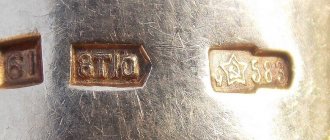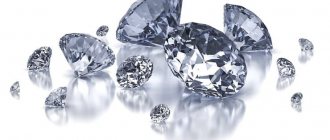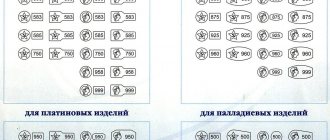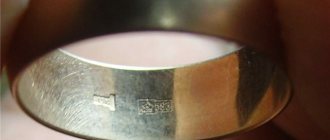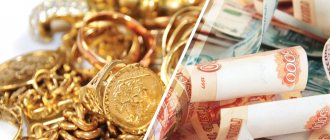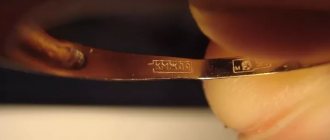Many lovers of gold jewelry still do not know that these items are made from impure metals. The true amount of precious metal is indicated using a sample.
It is generally accepted that USSR gold is bought from precious metals dealers much more than modern gold. After all, Soviet jewelry has been historically proven to be more resistant to the aggressive effects of acids.
Let's try to figure out how much better Soviet precious metals are than modern ones. Let's find out which alloy is more reliable and beautiful.
What was the standard of gold in Soviet times?
In 1922, during the formation of the USSR, a gold sampling system developed back in 1798 was used. Then the calculation was based on the Russian pound, which included 96 spools.
The famous Soviet standard is 583 gold.
Since 1927, it has lost its meaning. The metric system was adopted. According to it, the sample shows the number of milligrams of noble metal in 1 gram of alloy per 1 kg. This calculation was borrowed from Europe.
The same calculation together with foreign countries made it possible for the Union to develop in the foreign market for precious metals.
To achieve this, the process of measuring gold purity for USSR jewelry was adjusted to generally accepted standards. The selection of samples was small. The country wanted to approve a single gold standard for everyone in the 583rd standard form.
Sample history
Since the times of the Soviet Union, people have become accustomed to believing that 583 gold is the best. But this is not entirely true: those who understand alloys immediately understood this. But for many ordinary people this was a big discovery. Evidence that gold is not of the highest quality is its deteriorating appearance, namely darkening many years after its purchase.
But Soviet jewelry has another useful feature - it is very durable and difficult to deform. This was done so that the thin rings, which were one of the best-selling rings at that time, would not bend and confuse buyers. If you compare the price per ounce of gold then and now, it has increased by $1,400. Given the rise in price, people are trying to buy products of the highest standard.
Samples of precious metals in the USSR
Let's take a closer look at all Soviet gold samples.
| Systems | Application | ||
| Metric | Zolotnikovaya | Carat | |
| 1000 | 96 | 24 | Purest silver, gold, platinum |
| 999,9 | — | — | Technical metals, commercial platinum and silver |
| 980 | 94 | — | The most precious gold things |
| 958 | 92 | 23 | High quality gold in some countries |
| 950 | — | — | Platinum items |
| 916 | 88 | 22 | High quality silver items |
| 900 | — | — | Gold and silver bars, coins |
| 975 | — | — | Silver items |
| 875 | 84 | 21 | Household silver items |
| 800 | — | — | Gold and silver household items |
| 750 | 72 | 18 | World class hallmark for valuable gold standards |
| 583 | 56 | 14 | For cheap gold jewelry. |
| 500 | 48 | 12 | For inexpensive gold jewelry and silver coins of “royal mintage”. |
| 375 | 36 | — | The most inexpensive gold items |
USSR gold earrings
Changes in the mark on gold items by year
In Russia, the practice of using stamps on valuable metals originated several centuries ago.
- 1899 - the mark depicted the profile of a woman’s face turned to the left. Next to it was the sample number and the initials of the district.
- 1908 - it changed a little, the woman’s profile turned to the right.
- 1927 - the mark on USSR gold acquired a completely different look - the head of a working man with the image of a hammer in the foreground. This corresponded to the political situation of those times.
- 1958 - five-pointed star with a hammer and sickle inside.
- Until 1965, the star was convex, then it acquired a flat shape. This image existed until 1994, when it was replaced by the profile of a girl with a kokoshnik on her head.
Is it true that Soviet jewelry is of better quality than modern jewelry?
We often hear that gold used to be better. Is this really so and how did Soviet-era jewelry differ from modern ones?
In Soviet times, jewelry was a real luxury. Ordinary women either did not have them at all, or they were carefully kept in a locked sideboard and worn only on special occasions; it was not customary to wear them every day. Few people could afford diamonds, and knowledgeable buyers looked for jewelry on consignment shops.
Gold rings, rings and earrings were of family value. They were given to girls for weddings or for the birth of children, passed down from grandmothers and kept for decades in a treasured box. The jewelry industry in Soviet times was nationwide, and the range was quite limited. Nowadays the shelves of jewelry stores are full of jewelry, the stores are filled with jewelry, but there is still an opinion that the quality of the jewelry itself was better, the gold was higher quality, and the stones were cleaner. Is it really?
Mandatory sample and stamp
The sample standard appeared after the Revolution. Then a stamp appeared with the image of a worker with a hammer and an alphabetic code, which was later replaced by a star with a hammer and sickle. The mark was affixed to all jewelry that met one of the standards specified in the USSR.
The sample showed the content of precious metal in one thousand weight units of the alloy from which the product was made.
In the USSR there were several samples: for platinum jewelry 950°, for gold jewelry 375°, 500°, 583°, 750° and 958°.
All jewelry was produced only in the 1st grade; some products made of amber and non-ferrous metals were allowed to be produced in the 2nd grade, but this was necessarily indicated in the documentation.
Jewelry was made to last forever. Durable and weighty rings with large stones that held thick paws could be worn for decades and passed on to children and grandchildren. The thicker the metal, the stronger it is: you won’t bend it, you won’t break it, and the stone won’t fall out. All the stones were securely fastened, and the clasps of the products almost did not break.
As for the quality of gold itself, there was a single GOST, which clearly stipulated the percentage of all metals. Now in the Russian jewelry industry there is also an OST for gold content, it must be at least 58.5%, but the content of other metals is no longer strictly determined. Modern products may contain more gold, but other metals may be different. This sometimes affects the quality and properties of modern products. To make the design beautiful, the metal is given low fusibility, which makes it easier to compress and wear out. So modern jewelry is much thinner and more elegant, they can indeed break or bend and require more careful handling.
Gems: natural or synthetic?
Large rings with a bright red ruby or a more elegant alexandrite became a symbol of the era. But if we talk about the authenticity and naturalness of Soviet stones, then in most jewelry they were artificially grown. They learned how to synthesize stones a very long time ago, even before the Revolution, so, to the surprise of many owners of grandmother’s antique jewelry, they often turn out to be artificial.
Since the 70s of the last century, scientists have obtained technology for the synthesis of purple-red corundum. These 1- and 2-carat stones, which appeared on the market in the 1880s, were called “Geneva rubies.”
In the 1980s, scientists from the Lebedev Physical Institute managed to grow an artificial diamond, cubic zirconia. This was a real breakthrough in the jewelry industry. Soviet citizens were not at all embarrassed that the stone was synthetic, and rings, earrings and pendants with cubic zirconia created a real sensation among fashionistas of the Soviet Union.
As for the familiar Soviet rubies, sapphires, tourmalines and alexandrites, most of them were also artificial. Pure natural gem quality stones have always been rare and sometimes cost more than diamonds.
Rings and earrings with large stones, popular among Soviet women, are artificially grown, but this does not mean that old Soviet jewelry has no value. Synthetic Soviet stones are of the highest quality and can be very beautiful.
Anna Zalesskaya / Domashny Ochag magazine
The exceptional quality of Soviet gold: myth or truth
During the times of Tsarist Rus' and the Soviets, all jewelry enterprises and retail outlets belonged to the state, it was impossible to see counterfeit goods on the shelves
The maximum permissible violation could be +/- 5 units from the sample declared on the product. But even now jewelry is made with the same deviation standards.
Soviet products were massive. The rings did not bend from strong compression, the chains did not stretch from rough influences. There were no hollow decorations, but the cost was appropriate. Most modern products are made taking into account the financial capabilities of the consumer - inexpensive bracelets, earrings, and other jewelry quickly break due to thin materials. This is where the story about the quality of Soviet gold originated.
Where was the 583 sample used?
The test was used for almost all types of jewelry. This includes bracelets, pendants, chains, and rings. Large rings were especially popular; they could weigh more than some bracelets. If you find them now, their appearance will be almost identical to how they were when you purchased them.
At the moment, this sample can be found rarely, since it is not accepted internationally and is considered a second-class alloy.
Now people are well aware of this, and in order not to risk their reputation, they do not buy such jewelry.
But at the same time, gold is popular in certain circles. Many people order custom jewelry made from this gold. Things made in the old style are especially beautiful. An alloy is used for them, which will give a reddish tint.
At the moment, if the sample is used, then for the following items:
- wrist watch;
- accessories;
- pens;
- keychains;
- earrings for piercing;
- souvenirs;
- products for decoration.
Turkish gold and demand for domestic jewelry products
30-40 years ago, the Soviet jewelry market was captured by Turkish products of 585 standard. The poor quality of the purchased jewelry caused a huge number of negative reviews from the population. This is not surprising, since Turkish gold was made using foil. Jewelry deteriorated before our eyes, became deformed, and completely broke due to slight mechanical impact.
The same misfortune befell precious stones imported from Turkey.
Countless complaints about counterfeit products led to a ban on their import by 2000.
Jewelry made from Turkish gold
A little later, store windows were again filled with Russian-made gold. To maintain the quality of manufactured products, GOST 6835-2002 dated August 1, 2002 was approved.
Today, the most popular Russian standard approved by this GOST is the 585th. It meets all foreign standards.
The role of Turkish gold
In the 80s and 90s, the 585 sample began to cause indignation among the Soviet people. This was due to the massive import of jewelry of this standard from Turkey, which was made using gold foil. These products fell apart and deteriorated from any unconventional influence on them, and also faded, changing their color, and were not durable, easily bent and deformed.
The same goes for precious stones. Their crafts were widely used for gold inserts. They were also not resistant to environmental irritants, and already in the first months they deteriorated and changed their color. Numerous complaints about the poor quality of the product provoked a ban, which was introduced in 2000.
After some time, gold from domestic producers returned to the shelves. It was of much better quality and did not cause any indignation on the part of buyers.
Linking the percentage of ligature to the shade of 583 samples
The idea that the color of a gold product depends on the amount of other metals used in it was developed thanks to the USSR.
Gold rings 583 samples
At that time, jewelry from 585 had a red tint, 750 had a yellow tint, and 375 had a pink tint.
As already mentioned, the color of a valuable metal is influenced by the percentage content of other metals in the product. Let's take a look at the table of color changes using sample 583 as an example.
| Silver | Nickel | Zinc | Copper | Gold | Color |
| 8,3 | — | — | 33,4 | 58,3 | Red |
| 18,3 | — | — | 23,4 | 58,3 | Pink |
| 36,0 | — | — | 5,7 | 58,3 | Green |
| — | 17 | 8,7 | 16,0 | 58,3 | White |
Hallmark 583 in the modern world: how jewelers and pawnshops evaluate it
After several decades, 583, the old standard of gold, fell from the first place in the popularity of precious metals. Today, disputes arise less and less frequently compared to 585 and 583 samples. However, the price of 585 samples is several hundred rubles per gram higher than the cost of its competitor.
Foreign jewelers speak negatively about 583 samples. However, their negative attitude is not true. 583 standard gold in the USSR, with proper maintenance, does not lose its beauty, because it has:
- radiance that does not disappear for years;
- bulkiness and reliability, which avoids damage;
- corrosion resistance.
585 gold wedding ring
Vintage jewelry to create original looks
Soviet gold jewelry from the USSR era is a range of memorable designs that can be used in modern looks! Such models are likely to be found in almost every family, which does not reduce their merits! How to wear Soviet jewelry today?
- “Raspberries” are colored stones surrounded by a circle of colorless ones. Earrings and rings “raspberries” are a variant of the “halo”; this arrangement of inserts remains a hit to this day. The advantages of “raspberries” are that even a small central stone in them looks luxurious due to the surrounding of small crystals. You can wear the Soviet “raspberry” in any elegant look; such models still look relevant today.
- “Tulips” - a large or medium-sized stone is sandwiched in a golden “tulip” of pronged petals. “Tulip” was used for earrings, rings and even watches. The insert seems to float in them, it is clearly visible from all sides, and the mount itself is very decorative. Today, “tulips” are hardly made because if you use a real gemstone, they would cost a fortune. You can use the laconic “tulips” that you inherited in business looks with a retro touch.
- “Sudarushki” are patterned (openwork or embossed) Soviet earrings made of gold in the form of an inverted kokoshnik, usually without inserts. They contain Slavic motifs, and this is a wonderful detail to the ethno-image.
- Turban rings are large rings without inserts with a flared front part and a rounded shape. Fits perfectly into the oversized trend!
- The “Shakhin” ring is a real hit of the USSR, the dream of every Soviet woman! The ring was decorated with a huge oblong stone set in a wide openwork base, tapering towards the back of the product. Now such a ring can be worn by girls who are no strangers to self-irony, because the fact that the stone is artificial is obvious. “Shakhinya” fits well into the mix of rings, becoming its accent.
Tips for caring for Soviet gold
Due to alloys contained in gold, it often darkens during use. This occurs especially actively with constant contact with human skin and oxygen. To prevent such changes, you need to learn how to properly care for them.
- Stir 250 ml. soap solution with five drops of ammonia;
- We lower the product into it and leave it for twenty minutes;
- We take it and rinse it with water at room temperature;
- Next, just wipe the jewelry with a cloth or a soft toothbrush until it shines.
Do not use household chemicals when cleaning.
They may contain alkalis and acids that affect the appearance of precious metals.
Reviews
My great-grandmother and great-grandfather passed on their former wedding rings to my sister and me. I was lucky - I got something bigger! So, when I was getting ready to get married, my groom and I decided to make their rings based on the chosen picture from the Internet. We collected all the unnecessary gold at home, including old rings. And the master made two of our rings from one great-grandfather’s ring; he didn’t need the rest of the products!
Maria P. g, Moscow
Alisa T. g, Ivanovo
I decided to say goodbye to the old gold I didn’t need (I had one earring lying around, a missing crown), and took it to the pawnshop. The buyer said that such metal is valued cheaper than modern metal. I'll try to go to another salon.
I lost my old gold chain, which I managed to buy back in Soviet times. I still can’t find something suitable for myself. Modern products seem too thin and fragile. And the thick chains still cost as much as a car.
Valentina P., Donetsk
What it is?
Precious metals traditionally include silver, gold and platinum. USSR 583 gold in pawnshops is still the most popular pawn, as it guarantees quality. Other metals with a positive oxidation potential, such as osmium or palladium, also fall into this category. But, since the latter are used extremely rarely, few people know about them.
Decoding the sample sign
The sample of a noble metal is its weight content in the alloy being tested. Information about this is indicated on metal ingots. By law, any alloy containing more than 30% noble metals must be assayed and properly hallmarked. This data is used in the manufacture of earrings, brooches, coins and other products, as well as when valuing them in a pawn shop.
Gold rings in a pawnshop
There are 4 systems.
- Metric - the number of milligrams in 1 g or grams in 1 kg of alloy. It has been adopted in Germany, France and other countries that have signed the convention on the control and hallmarking of products made from precious metals. There is no doubt what samples of gold were in the USSR, since the USSR, the Russian Federation and all CIS countries also support the metric system. Data on the permissible weight ratios of alloys adopted in the USSR in 1927 are contained in the table. The photo shows gold items 585.
- Carat - used mainly in the USA and Canada. The karat system is used only in relation to gold alloys and indicates the number of carats in a catchable 24 carat of the alloy being assayed. That is, a 9-carat alloy contains 0.375 g in 1 g, and a 24-carat alloy contains no less than 0.999 g, that is, it corresponds to 999 metric standards. Using the corresponding tables, it is quite easy to convert carat measurements to metric ones.
- Zolotnikovaya is purely Russian. Based on the ancient scale, according to which the value is measured by the number of spools of pure metal in relation to 96 spools - 1 pound of alloy. According to such measurements, in an alloy of 36 spools, the mass of pure gold or platinum reaches 0.375 g per 1 g of alloy, and the designation of 56 spools corresponds to 583.
- Lot - used in Germany and Britain for silver. In this case, the conventional weight unit mark contains 16 lots, in fact, 6 lots correspond to 375, 12 - 750, and 14 - 875.
Metal color chart

